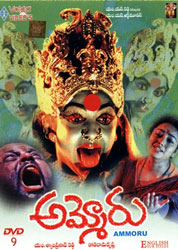 A groundbreaking special effects extravaganza from South India—or Tollywood—and an all-around mind-roaster. Completed in 1995, the film was widely lauded for its “up to the minute technical expertise.” Obviously that’s no longer the case, but AMMORU still excels as lightning paced, thrill-a-minute insanity.
A groundbreaking special effects extravaganza from South India—or Tollywood—and an all-around mind-roaster. Completed in 1995, the film was widely lauded for its “up to the minute technical expertise.” Obviously that’s no longer the case, but AMMORU still excels as lightning paced, thrill-a-minute insanity.
AMMORU was by Tollywood standards a massively scaled and budgeted film. It reportedly took three years to make and employed the services of British special effects technician Christopher Holmes. The film was noteworthy for utilizing Eastern mythology in a manner that seemed relevant to late-Twentieth Century India (meaning much of it will be incomprehensible to Western viewers). But its real claim to fame was its extensive and elaborate use of CGI, which in 1995 was revolutionary even by Hollywood standards.
Years ago the goddess Ammoru ascended to Earth to protect an impoverished village from a deadly virus. She’s remained in the village in the form of a statue, located in the home of a wealthy family of corrupt scumbags. The virginal Bhavani, a stout devotee of Ammoru, is unfortunately living with the family, whose ranks include the black magician Gorakh. Gorakh is a slimy man under the spell of the evil goddess Chanda (whose malevolent cackle is heard on the soundtrack every time Gorakh appears); one night he tries to bury Bhavani alive in an effort to gain some kind of supernatural power. He’s caught in the act, though, and sent to prison. Gorakh’s family is devastated, and pins the blame on Bhavani.
They collectively try to kill Bhavani in various twisted ways. Eventually the goddess Ammoru intervenes in the form of a little girl who insists on staying in the mansion and watching over Bhavani. The family continually tries to do her in, but the Ammoru-girl is always there to put a stop to their shenanigans. Eventually they opt to kill Ammoru by enclosing her in a burlap sack and drowning her in a lake. The attempt inevitably fails and Ammoru returns to protect Bhavani. But it’s the latter who ironically decides she’s had enough of the girl, ignorant of her real identity, and orders her to vacate the premises.
This means that now Bhavani is left to face the family’s torments unprotected, an especially unfortunate turn of events since Gorakh has just been released from prison. Gorakh wastes no time putting his evil wiles into action: he locks Bhavani inside the mansion, tortures her husband and kills her infant child. Bhavani clearly needs the help of Ammoru more than ever–too bad she sent her away!
Tollywood movies tend to be mistaken for the slicker, better-funded Bollywood productions stemming from the more prosperous regions of India—and no wonder, as they feature many identical elements. Outrageously juiced-up melodrama is a constant, as are elaborate song and dance numbers, freewheeling genre-hopping narratives and inflated two hour-plus running times. All are in evidence in AMMORU, although the copious CGI effects were a relatively new component which director Kodi Ramakrishna uses in consistently invigorating and imaginative fashion.
Apparently Ramakrishna employed CGI because he couldn’t find any other way to properly convey the wild, grandiose imagery he had in mind, such as lake water forming into a giant hand and a large spire launching itself from a woman’s forehead. The primitivism of the effects often lessens their effect, but the film moves so fast and contains such an incident-packed narrative that it always holds one’s attention. I understand several different Indian folk tales were woven into the narrative, which makes for a cluttered and oft-incoherent story (but then, I believe fully understanding this film would require a working knowledge of the Bhagavad Gita).
It all comes together, though, in the totally amazing effects-ridden climax, which combines song and dance with spurting blood and freaky transformations. It’s an altogether masterful sequence, and goes a long way toward forgiving the rest of the film’s shortcomings.
Vital Statistics
AMMORU
M.S. Arts
Director: Kodi Ramakrishna
Producer: M.S. Shyamprasad Reddy
Screenplay: Satyanand
Cinematography: Vijaya Kumar C.
Cast: Ramya Krishna, Soundarya, Suresh, Rami Reddy, Sunayana, Vijaya Y., Babu Mohan, Kallu Chidam
